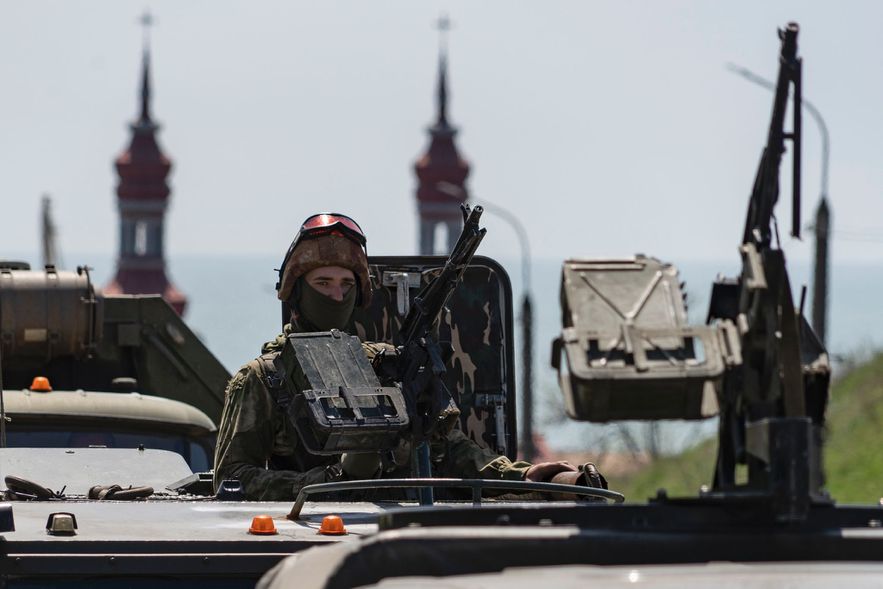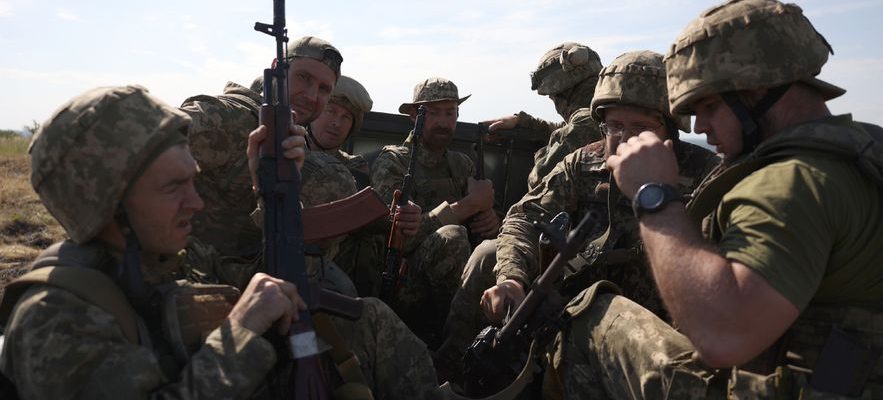He is one of the most knowledgeable observers of the war in Ukraine. The historian Michel Goya, who spent part of his military career in the marine troops, has just published The Bear and the Fox (Perrin), co-written with Jean Lopez, where he analyzes military operations since the invasion of February 24, 2022.
While the Ukrainian army launched, at the beginning of June, a counter-offensive expected for several months, already managing to retake a few tens of square kilometers of territory from the Russians, he outlines the challenges awaiting his forces.
L’Express: Are these first days of counter-offensive going as hoped for Ukraine?
Michael Goya: Yes, for the moment, there is no surprise, with a rate of progression within the norm. The Russians, them, resist correctly, it is not at all a stampede. We are really at the very beginning of an operation that will take several more weeks. It takes place in particular on a front line of a hundred kilometers between the Dnieper and Vulhedar, with uneven progression. The first echelon of the attack is mainly made up of brigades in place for months, while a second echelon of nine brigades remains on standby.
Vladimir Putin speaks of “catastrophic losses” for Ukrainians. Is this really the case?
It’s always difficult to know, but it’s quite normal for there to be losses in combat: it’s a bit like the principle of war… The destruction of equipment counted by the Oryx site already gives an indication of the violence fighting, with 35 Ukrainian tanks destroyed in total, half of which were Western models such as the Leopards and the Bradleys from three newly formed brigades engaged in combat. Even if it would be three times more, it is all in all quite modest, while a thousand combat vehicles are currently on the attack. We are very far from the delusional figures of Vladimir Putin [160 chars et plus de 360 blindés].
What difficulties are the Ukrainian forces likely to face?
To be able to move forward, you have to succeed in neutralizing the Russian third dimension, that is everything that comes from the sky: shots from planes, attack helicopters, artillery, drones, remotely operated munitions, etc. For this, you need anti-aircraft defense, which the Ukrainians may not have enough of.
You also have to counter-battery the Russian artillery, which seems to work quite well. Opposite, the Russians have established artillery plans. If he sees the Ukrainians arriving at such a crossroads, a Russian captain will order, for example, “shooting number five”, previously calculated and set at this intersection. Then, you have to succeed in progressing on a terrain with obstacles. The Ukrainian sappers will open passages to approach Russian strongpoints and seize them. It is a matter of coordination, means and courage.
Precisely, how do the fighters experience such perilous missions?
There will be quite a few close combats. Ukrainians will physically see quite a few Russians, they are fighting ghosts. The threat comes from the sky or from the ground with the mines. If they arrive at the strongpoints, in general, these will have been evacuated. They will use their rifle very little against human targets. What we are going to ask of them is therefore not Homeric courage, with great hand-to-hand combat like in the movies, but more Stoic courage, a determination to go on for days, weeks, under the fire and threat, with casualties. It will be very exhausting physically, psychologically too, because you are in a constant situation of tension. So you have to have time to rest. But being constantly attacked can be even more exhausting for the defender.
What is expected of the officers and non-commissioned officers who direct the manoeuvres?
In general, they work by mission: they are given an axis of progression, with an action box, that is to say an area with a right limit and a left limit, where there are friends. You also have to manage the coordination with the neighbors, to avoid shooting at each other, which is not always easy. Your objective is to arrive at such line and to seize such position. You have to solve a multitude of problems, like blowing up mines, opening passages, spotting the enemy. You are in constant communication with your boss to inform him of your progress and everything that is happening. In the event of a problem, you can ask him for artillery support. You can ask to be relieved, or withdraw if the losses are too great. The role of the leader is not to fight, it is to make reports, to manage information, orders, all under stress.
Ukrainian soldiers in the Donetsk region (east) on June 8, 2023
© / afp.com/Anatolii Stepanov
The second Russian defensive curtain, about twenty kilometers deep, will it not be more difficult for the Ukrainians to pass?
Yes, the Russian forces are organized in depth with a relatively light first echelon, which they know will suffer the full effects of Ukrainian artillery. It serves to delay and disorganize the enemy as much as possible. The real resistance must be made a few kilometers behind, at the second echelon, where the strongest positions are, a little more sheltered from the Ukrainian artillery, with reinforcements which can arrive from the rear. For Ukrainian troops worn out by the first battles, the question will arise of continuing, depending on the levels of losses. Then you have small towns made up of strongholds, like Tokmak.
When can the offensive be considered a success?
To achieve their goal of driving the Russians out of their entire territory, the Ukrainians need big wins, not nibbles on the pitch. They will only be able to claim victory when they have planted the flag on an important objective, such as Melitopol, or Berdiansk on the Sea of Azov. If they capture Tokmak, for example, and go no further, that won’t be a major, war-changing victory. It will be a partial failure. Unless it causes considerable losses on the Russian side and facilitates new operations.
But let us remember that after the two victories of Kharkiv in September then Kherson in November, they did not have the resources for a third or a fourth victory likely to break the Russian army. Especially since the Russians had reacted by triggering a partial mobilization which enabled them to send at least 40,000 soldiers directly to the front, as a sacrifice. If the Ukrainians break through the front as far as Melitopol, this may also provoke a general mobilization of the Russians or other reactions which would perhaps compensate for the Ukrainian success on the ground. We do not know anything.
How does the current Ukrainian offensive differ from those carried out in Kherson and Kharkiv at the end of last summer?
The one in Kharkiv was almost an anomaly. The defensive apparatus was very light, the Russians even put dummies in the trenches to hide the fact that they were few in number in the region. The Ukrainians saw it, they mounted an operation of opportunity, very quickly, attacked and broke through quite easily. This is the only time they managed to dislocate the Russian device in this war.
“This Russian army has gained in size, but lost in capacity”
In Kherson, the defenses of the Russians were organized, solid, but with little depth. It looked like some kind of siege, because they depended on crossings over the Dnieper River that the Ukrainians were able to hit, partly cutting them off from the rear. But it took two months for the Ukrainians to take Kherson. In the Zaporizhia area of Donetsk, the Russian defense is three times stronger than it was on the Kherson bridgehead. And it has depth. The Ukrainians will have to overcome tens of kilometers of defense before reaching “free ground”, where they can conduct more mobile combat, such as a tank battle on the side of Melitopol.

Russian soldiers in Berdyansk, April 30, 2022 in Ukraine
© / afp.com/Andrey BORODULIN
The Russian army would have lost more than 200,000 men, including 50,000 dead, according to Westerners. Are the fighters at its disposal able to withstand the shock?
This Russian army has gained in size, but lost in capacity. Generally speaking, the Russian winter and spring offensive was a failure. Defensively, however, things are always easier tactically, so we’ll see if they’ll be better. The quantity of men, of materials, is not the most important. What makes the difference is the level of tactical quality, which depends a lot on the value of coaching. This is a fundamental problem for the Russians, where it has always been low level, but also valid on the Ukrainian side. Everything depends on the losses: beyond a certain point, you no longer progress, you regress, because you have lost too many experienced elements. The Ukrainians, defensively, were very good. But we do not know what they will give offensively.
Will the outcome of the battle be decided on how to use reserves?
Yes of course. The Russians had already engaged their 127th Brigade in counterattack, but it didn’t go well. The challenge of deep strikes for the Ukrainians is to paralyze these Russian reserves as much as possible. Next is determining how far to engage the first echelon units. When should they be picked up? It’s always a delicate moment, with units that don’t know the terrain and have to take it on their own. From a strategic point of view, if the first echelon did not progress at all in Zaporizhia, the second echelon could be engaged in the province of Luhansk. It’s difficult, but not impossible. In any case, when you have committed your reserves, you no longer have a choice: you are obliged to succeed.
There destruction of the Nova Kakhovka dam does it offer opportunities in Kyiv?
Crossing the Dnieper was already very tricky. With the destruction of the dam, it became even more difficult. You can cross it with a Zodiac to conduct raids, but you cannot mount a large operation, which requires setting up bridges for heavy equipment. As for the reservoir, the water level has dropped a little, but it is still very wide, a muddy area not necessarily passable.
After this offensive, how long will it take Ukraine to mount the next one?
This will depend on the state of their resources at the end of this operation. If the Ukrainians have exhausted all their means, it will take months to replenish them. If they dislocate the front, they’ll have enough left under the sole to try something else fairly quickly. It will also depend on the Russian army: if it is very weak, perhaps with less means, the Ukrainians will be able to continue to fight, in more mobile forms, with less artillery. We will have to ask ourselves these questions in a few weeks.
